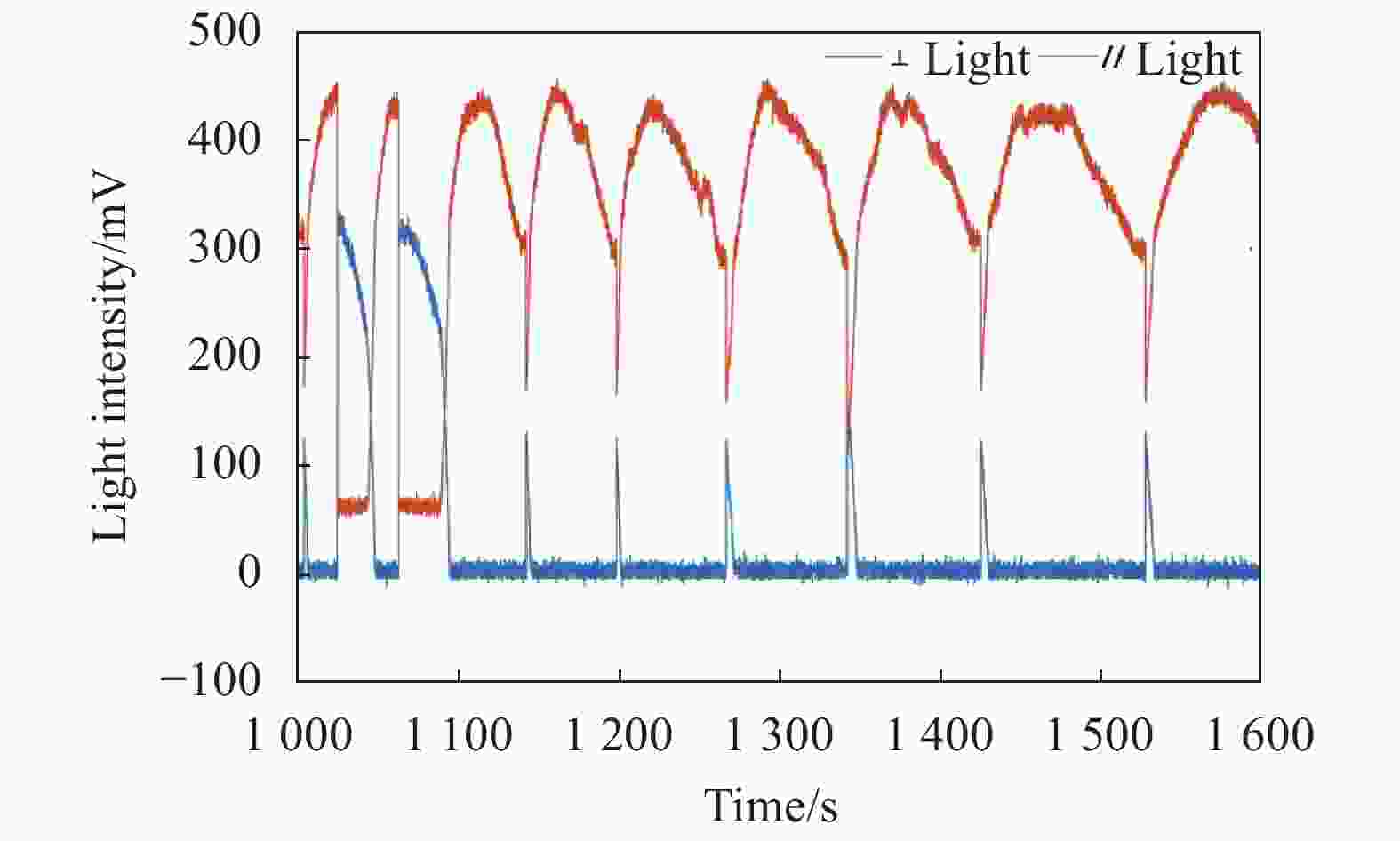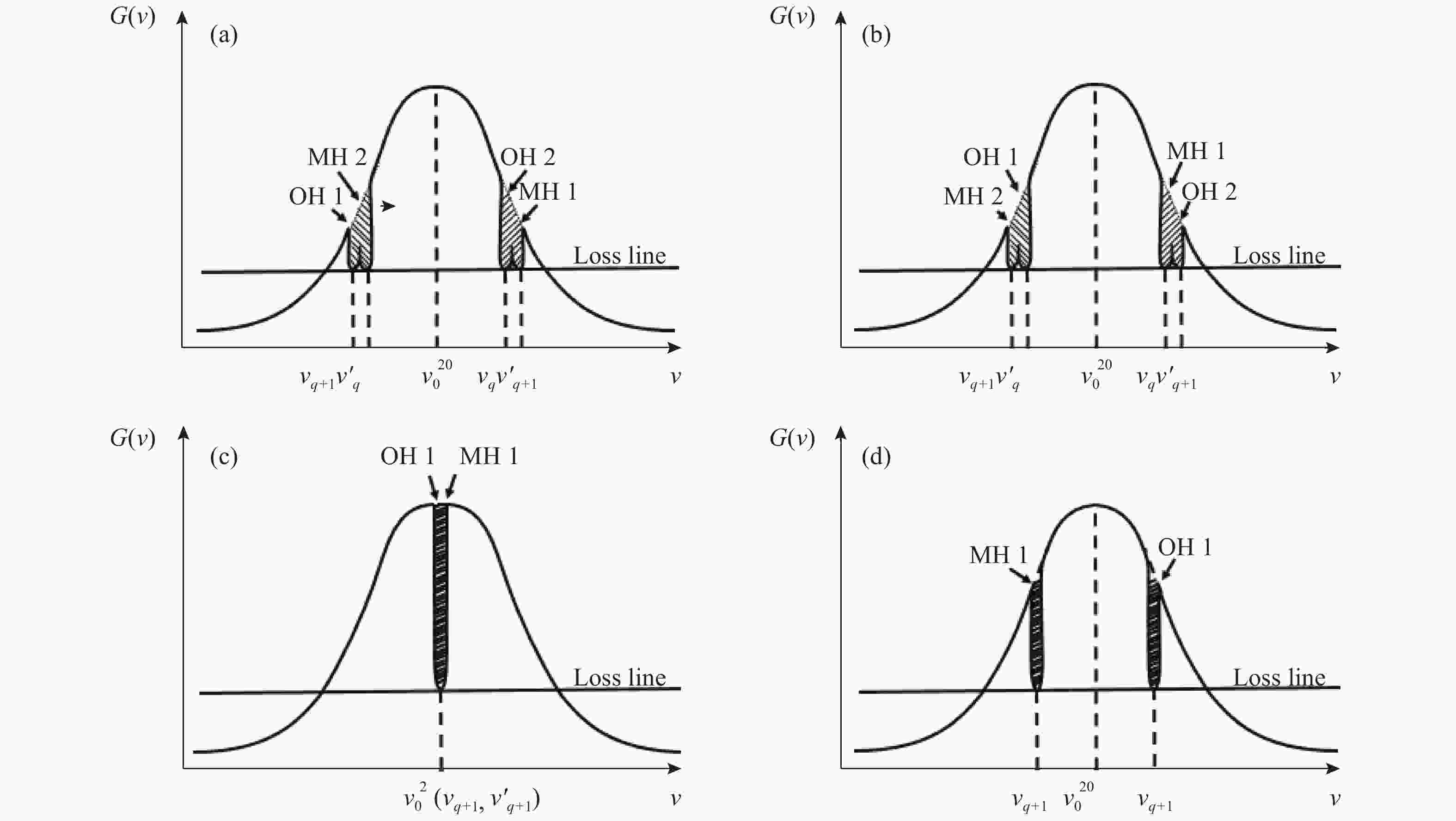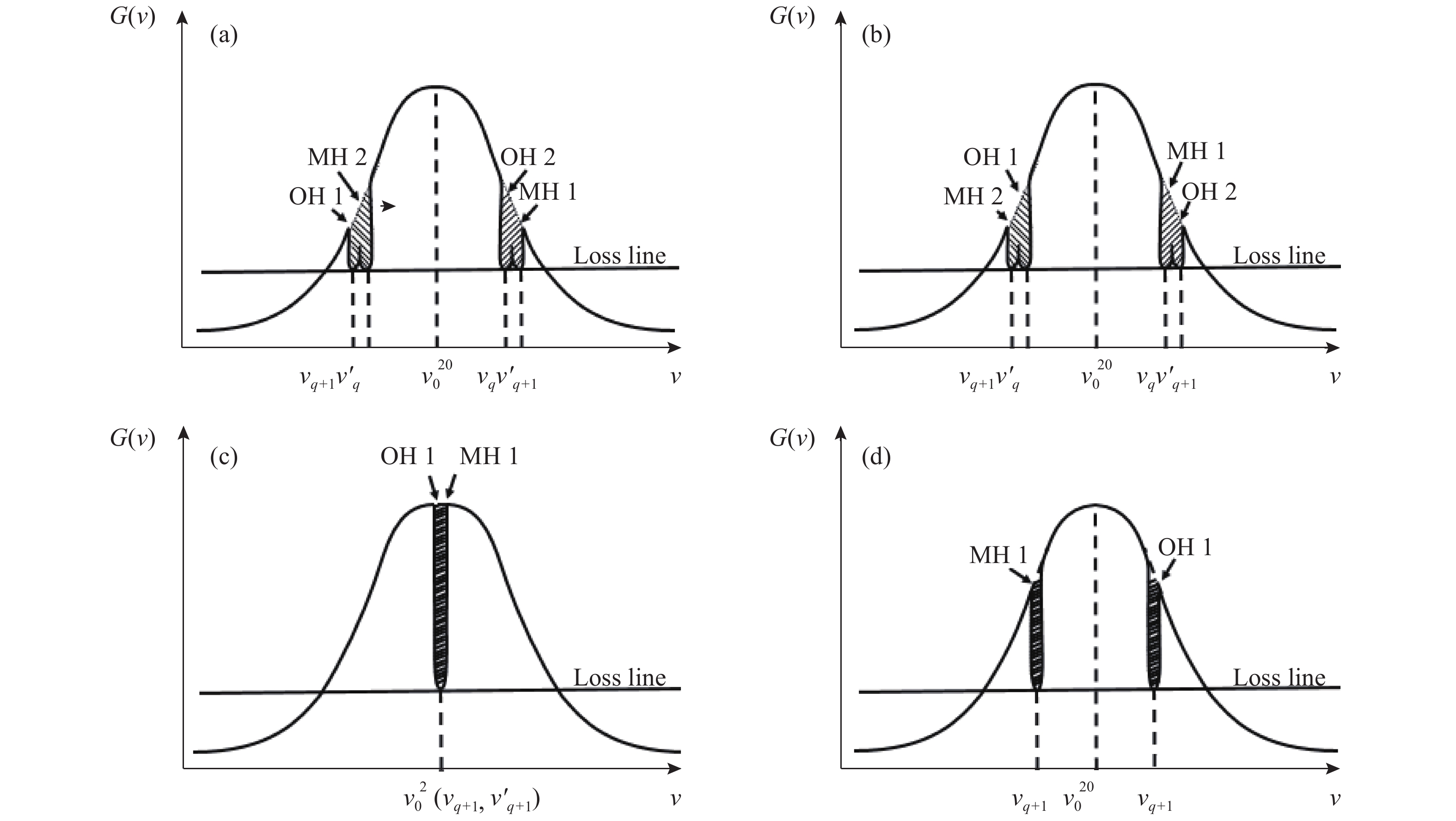HTML
-
为了输出稳定的频差,模式竞争[1]是氦氖激光器中一个被重点研究的物理特性:参考文献[2]研究了频率分裂量与腔内石英晶体片调谐角(晶轴与光线夹角)的关系,发现频率分裂量不随调谐角线性变化,且调谐角在15°附近、20°附近等位置时,模式竞争非常强烈;参考文献[3]设计了使腔内石英晶体片绕其面法线旋转整周 产生频率分裂的方案,旋转角度在0°~20°之间的频率分裂量非常小,处于强模竞争状态;参考文献[4]研究发现当外力在8~ 40 N时,相对频率分裂量与外力有很好的线性关系,但这种应力双折射激光器同参考文献[2-3]研究的自然双折射激光器一样,往往由于模式竞争无法输出40 MHz以下的稳定频差。Floch对偏振跳变的理论解释和跳变条件展开了讨论,指出在一般的双折射双频激光器中,偏振模的跳变遵循抑制机制[5]。
一般所讨论的HeNe激光器的模式竞争是基于增益介质为Ne双同位素的情况,文中介绍了HeNe激光器两种正交模式的一种异常偏振现象,首先通过扫描干涉仪判断是否存在频率分裂模式共振的情况,再结合光强调谐曲线在频差调整前后的变化,通过HeNe激光器频率在增益曲线上的空间烧孔原理对由于充入单同位素Ne气而引起的模式竞争与跳变现象进行了具体分析,补充了这方面的研究。
-
HeNe激光器开机达到热平衡前,其谐振腔的长度总是在增大,在这一过程中,则有一系列不同级次的谐振频率(
${\upsilon _{q - 1}}$ ,${\upsilon _q}$ ,${\upsilon _{q + 1}}$ ······)依次扫过以${{\rm{\upsilon }}_0}$ 为中心频率的Ne原子增益曲线。由于相邻频率的模式是正交的,当谐振腔长度满足出光带宽内出现双纵模的设计要求(谐振腔长起到控制纵模间隔的作用),则激光器输出光同时包含两种正交的偏振模式。对于双折射HeNe激光器而言,其输出平面镜 (应力双折射元件)未加力调制时引入相位延迟很小,产生的频差不足40 MHz,两个分裂频率总有一个是熄灭的,此时出光带宽内存在的则是两个不同级次的正交分裂模式[6-7],如图1所示,其中实线对应的频率在出光带宽内是振荡的,虚线对应的频率在出光带宽内是熄灭的。由于频率在增益线不同位置获得增益是不同的,越靠近中心频率${{\rm{\upsilon }}_0}$ 获得的增益越多,输出光中两种模式的偏振态在腔长调谐过程中总表现出“此消彼长”的亮暗变化。在测试一支双折射HeNe激光器的性能时(未对腔镜加力),观察到该激光器在谐振腔长增大过程中出现双模异常偏振的现象:一种偏振态表现为常亮,另一种偏振态表现为常暗,只有在换模时,后者才有机会振荡但又会迅速熄灭,同时它们的光强功率呈反向变化,说明两个偏振态的模存在强烈的竞争,且在换模过程中发生了模式跳变,这种情况下不能输出稳定的频差,严重影响激光器的使用。
-
研究上述双模异常偏振现象的实验装置如图2所示,激光器输出光经分光镜后被分成两路,一路被用于通过扫描干涉仪与示波器分析激光纵模特性,另一路被用于记录两种模式的光强数据。
图中所测激光器的谐振腔长为140 mm,工作电流为2 mA,输出功率为0.34 mW;BS为分光镜;PBS为偏振分光镜;PIN为光电池;R为反射镜;P为偏振片;SI为扫描干涉仪;Os为示波器。
-
对于上述双模异常偏振的现象,需要在腔长调谐过程中观察是否出现频率分裂模共振的情况。
图3为使用扫描干涉仪在激光器谐振腔长增大过程中依次观察到的激光纵模频谱图,横坐标单位是ms,激光纵模纵坐标单位是mV,扫描干涉仪驱动电压三角波的单位是V。图中电压幅值相同的模式为被重复扫描的同一频率,它们的间隔宽度为扫描干涉仪的自由光谱区宽度(1 870 MHz);相邻模式则表示不同级次的激光纵模,它们的间隔宽度均为1 050 MHz。在谐振腔受热而长度增大的过程中,激光器输出的两种正交模式沿着频率轴向右移动。从图上可以看出,出光带宽内一种模式的幅值升高,与之相邻模式的幅值就下降,这种模式从生起到熄灭的现象反映了不同纵模的竞争情况。
考虑到扫描干涉仪的分辨率只有10 MHz, 不容易看出同一激光纵模上是否存在两种分裂模式共振的情况,一种可行的办法是将图2中的偏振片旋转一周,由于偏振片轮流阻止两种正交模式的光通过,若两个分裂模均可振荡,则示波器上纵模波形的宽度轮流发生变化:左侧收缩宽度→右侧收缩宽度→左侧收缩宽度。实验中测得波形的宽度未发生任何变化。
当激光器管体温度比较稳定时,采用风冷的方式反方向调谐腔长,即使频率往减小的方向缓慢移动,测试的结果同样未在激光纵模上观察到双模共振的情况。
-
将激光器两种正交模式的偏振态分别记作//光和⊥光,它们的光强调谐曲线,尤其是曲线的形状、大小等特征能为分析纵模特性提供更多细节。
两种偏振态的光强调谐曲线如图4所示,从图上可以看出://光几乎一直处于振荡状态,说明
$\upsilon $ //在模竞中属于优胜频率,而⊥光只有在换模过程中才能振荡,此时两种模式还发生了跳变,但//光和⊥光在突变点上不是完全按照对方的曲线继续延伸[8],因此⊥光很快又熄灭了。实验观测到的结果为强模竞争现象,且考虑到激光器腔镜内不合适的相位延迟量可能是造成偏振模跳变的原因,采用弹性加力[9]的方法增大腔镜内的相位延迟量(对应频差为42 MHz),此时双偏振态的光强调谐曲线如图5所示,但从图上可以看出双模竞争的强度也没有本质改变,且偏振跳变的现象也没有消除,这说明腔镜内的小频差不是上述引起模式异常偏振现象的原因。
-
当谐振腔内充入Ne气成分不同时,光强调谐曲线的对称性受到很大影响,且Ne20与Ne22的含量比不同时,模竞争在出光带宽内出现的位置也会不同。通过对激光纵模特性以及光强调谐曲线的分析可知,发生在单同位素HeNe激光器(增益介质仅为Ne20)增益曲线烧孔中的强模竞争是导致上述模式偏振异常的原因,这种在空间烧孔内的竞争同时包含相邻纵模之间的竞争以及频率分裂模之间的竞争,具体过程如下。
对于HeNe激光器,其线型来源于以多普勒展宽为主的综合展宽,因此在Ne20增益曲线上,一个谐振频率仅能烧出一个原孔(OH)和一个像孔(MH),频率的增益由这两处烧孔内的粒子提供,越靠近Ne20增益曲线中心频率
$\upsilon _0^{20}$ (不含中心频率),烧孔的面积越大,频率获得的增益越多。但相较于增益介质为双同位素Ne气的情况[10](例如Ne20∶Ne22=1∶1,一个谐振频率在Ne20和Ne22增益曲线上均可烧出一个原孔和一个像孔),单同位素下的激光频率需要在更靠近增益线中心频率的位置才能振荡。当激光器腔长调谐至双纵模的工作状态,如图6(a)~图6(b)所示,此时谐振频率
${\upsilon _q}$ 即将移出出光带宽(所获增益逐渐减小),下一级的${\upsilon _{q + 1}}$ 进入了出光带宽(所获增益逐渐增大),它们在重叠的烧孔内还将争夺共用的增益粒子。由于//光通过腔镜的光程要比⊥光的光程小,因此分裂频率中$\upsilon $ //要比$\upsilon $ ⊥大,且$\upsilon $ //也是率先进入出光带宽并形成振荡的,结合图4分析知,在当前的换模过程中,偏振态的第一次跳变由//光变成⊥光,即振荡的模式由$\upsilon _q^{//}$ 跳变成下一级的$\upsilon _{q + 1}^{ \bot }$ ;当$\upsilon _q^{//}$ 彻底移出出光带宽,激光器又恢复成了单纵模工作状态,而$\upsilon $ //在模竞争中属于优胜频率,所以模式又从$\upsilon _{q + 1}^{ \bot }$ 跳变成$\upsilon _{q + 1}^{ / / }$ ;当谐振频率继续移至增益线中心频率$\upsilon _0^{20}$ 处,如图6(c)所示,谐振频率在$\upsilon _0^{20}$ 两侧的烧孔重合在了一起,烧孔的总面积反而缩小了,需要补充的是,由于$\upsilon _{q + 1}^{ / / }$ 先移至$\upsilon _0^{20}$ 处,振荡的模式有可能从$\upsilon _{q - 1}^{ / / }$ 重新跳变回$\upsilon _{q + 1}^{ \bot }$ ;当谐振频率继续移动,如图6(d)所示,${\upsilon _{q + 1}}$ 与${\upsilon _{q + 2}}$ 将开始下一轮的模式交换,如此循环,便形成模式的异常偏振现象。 -
谐振腔内增益介质Ne气的成分是除频差外影响HeNe激光器模式竞争的又一重要因素。
文中详细介绍了单同位素HeNe激光器偏振态变化的具体情况,分析了单同位素Ne对模式竞争的影响,给出了检测单同位素HeNe激光器的方法,这对于HeNe激光器的制造与检测非常重要。










































 DownLoad:
DownLoad:




